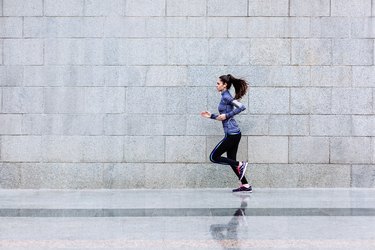
Your speed depends on the length of each stride and the rate at which you turn strides over. If you want to go faster, you have to increase either stride length or stride turnover. The length of your stride depends on your height, your fitness level and your body's individual biomechanics.
Regardless of the length of your stride, a faster stride rate of 180 to 200 steps per minute may be the best way to improve your running performance. ACE Fitness recommends finding your "own" perfect stride length and sticking with it.
Video of the Day
Video of the Day
Dependent on Distance
Shorter distance races call for longer strides. In the 1984 Olympics, women demonstrated stride lengths averaging 4 feet 10 inches during the marathon and longer stride lengths averaging 6 feet 8 inches during the 800 meters. Men also had a longer average stride during shorter distances, covering an average of 7 feet 9 inches with each stride in the 800 meters and an average of 6 feet 8 inches in the 10k.
Read more: How to Develop a Longer Running Stride
Runner's Height Factors
Additional analysis of stride length in sprinters found average length was dependent on height. The website Brian Mac Sports Coach notes that research in the 1970s determined that sprinters' stride length was equal to 1.14 to 1.17 times the athlete's height. Alternative research performed on a synthetic, rather than a cinder, track determined stride length as 1.35 times the athlete's height.
Read more: Do Taller People Run Faster?
Why Averages Are Misleading
Declaring there is a method to figuring the exact average stride length in humans is suspect, though, because people have different approaches to running. Some elite athletes go faster by taking short strides frequently, while others take fewer steps per minute but cover far more ground with each step.
The reasons for these chosen methods of running aren't clear, but they could have to do with whether an athlete is more skilled at producing power or has a more responsive neuromuscular system that turns the legs over faster.
Longer Strides Require More Energy
Longer strides tend to use more energy. Thus, fitter runners may be able to manage longer average strides than less fit runners. Stride length is also dependent on hip mobility and flexibility — if you don't have full range of motion in your hip socket, you can't step as far forward. Glute muscle strength also factors into stride length. You need strong buttocks muscles to pull your leg behind you after taking a large step forward.
Focus on Stride Rate Instead
Elites' stride rates vary, but usually only within 20 to 30 steps per minute. Although increased stride length can play a role in improved speed, increasing your stride rate is likely the best way of making your runs more efficient. A stride rate demonstrated by almost all elite sprinters and distance runners of between 180 and 200 steps per minute means your strides are short enough so that your feet land under you.
The average recreational runner goes at about 170 to 180 steps per minute — which is not ideal. With a slow stride, your feet land ahead of you, and you have to use your muscles to pull forward and catch up. Longer, slower strides increase your risk of injury because you spend more time in the air and land harder with each step.